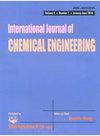Optimization of Essential Oil Extraction from Bitter Leaf (Vernonia Amygdalina) by Using an Ultrasonic Method and Response Surface Methodology
IF 2.4
4区 工程技术
Q3 ENGINEERING, CHEMICAL
引用次数: 0
Abstract
Bitter leaf (Vernonia amygdalina) is a common bush or small tree that grows in tropical Africa. In the Ethiopian highland, the bitter leaf has been classified by the farmer as a versatile tree with high biomass yield and easy propagation. It is also well known in traditional medicine and nutritional use. The objective of this study was extraction and optimization of essential oil (EO) from the bitter leaf by using the ultrasonic extraction method and response surface methodology. The experiment was designed by Box–Behnken Design (BBD) with three factors to investigate the effect of sonication time (10 min to 30 min), ultrasonic power (100 to 200 W), and liquid-solid ratio (4 to 8 ml/g (ml of solvent per g of bitter leaf powder)). The significance of the process variables was analyzed using analysis of variance (ANOVA), and the quadratic model was fitted to the experimental results. Thus, the independent variables, sonication time, sonication power, liquid-solid ratio, and their interactions contributed a significant effect on the yield of extraction. As the result of RSM optimization, the best yield of EO was found at sonication time (17.263 min), sonication power (150.677 W), and liquid-solid ratio (6.811 ml/g). Experiments conducted under these conditions resulted in an EO yield of (4.185% g/g). The results exhibited that the RSM and BBD were effective for optimization of studied ultrasonic process variables for the maximum yield of EO from the bitter leaf (V. amygdalina).超声法和响应面法优化苦叶挥发油提取工艺
苦叶(Vernonia amygalina)是一种常见的灌木或小树,生长在热带非洲。在埃塞俄比亚高地,苦叶被农民归类为一种生物量高、易于繁殖的多用途树木。它在传统医学和营养应用方面也很有名。本研究采用超声波提取法和响应面法对苦叶中的精油进行提取和优化。该实验由Box-Behnken设计(BBD)设计,有三个因素来研究超声处理时间(10 最小至30 最小值),超声波功率(100至200 W) 和液固比(4比8 ml/g(每g苦叶粉末ml溶剂))。使用方差分析(ANOVA)分析过程变量的显著性,并将二次模型与实验结果进行拟合。因此,自变量、超声处理时间、超声处理功率、液固比及其相互作用对提取率有显著影响。RSM优化的结果表明,在超声处理时EO的产率最高(17.263 最小值),超声功率(150.677 W) ,液固比(6.811 ml/g)。在这些条件下进行的实验导致EO产率为(4.185%g/g)。结果表明,RSM和BBD对于优化所研究的超声波工艺变量以获得苦叶(V.amygalina)EO的最大产量是有效的。
本文章由计算机程序翻译,如有差异,请以英文原文为准。
求助全文
约1分钟内获得全文
求助全文
来源期刊

International Journal of Chemical Engineering
Chemical Engineering-General Chemical Engineering
CiteScore
4.00
自引率
3.70%
发文量
95
审稿时长
14 weeks
期刊介绍:
International Journal of Chemical Engineering publishes papers on technologies for the production, processing, transportation, and use of chemicals on a large scale. Studies typically relate to processes within chemical and energy industries, especially for production of food, pharmaceuticals, fuels, and chemical feedstocks. Topics of investigation cover plant design and operation, process design and analysis, control and reaction engineering, as well as hazard mitigation and safety measures.
As well as original research, International Journal of Chemical Engineering also publishes focused review articles that examine the state of the art, identify emerging trends, and suggest future directions for developing fields.
 求助内容:
求助内容: 应助结果提醒方式:
应助结果提醒方式:


